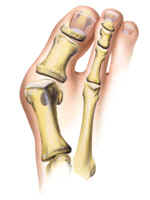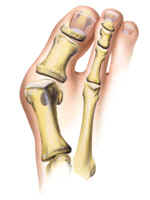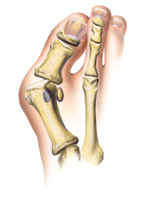Bunion Surgery Treatment
The experts at Nagler Foot Center Houston offer surgical measures to treat bunions. Let’s read more about the deformity and bunion surgery.
The experts at Nagler Foot Center Houston offer surgical measures to treat bunions. Let’s read more about the deformity and bunion surgery.

Simple Bunion

Moderate Bunion

Severe Bunion
The joint at the base of the big toe or "great toe" is a complex part of the front of the foot. Bones, tendons, and ligaments, all work together to transmit as well as distribute the body’s weight, especially when you move. Therefore, it is important for individuals to understand that any kind of abnormal stress to this joint for a longer period may result in bunion deformity.
A bunion is the protuberance of tissue or bone around the joint. The enlargement will occur either on the outside the foot or at the base of the great toe. The bunion at the base of the great toe occurs when you wear tight pointed shoes and the big toe starts moving towards the smaller toes. The pressure on the joint pushes it in an outward direction, resulting in the formation of a bunion.
Women face the problem of a bunion much more often than men because they wear tight, confining, pointed, and high-heeled shoes. Old people are also prone to bunions because there are more chances of arthritis affecting the big toe joint.
Most of the bunion cases that we come across are the result of faulty mechanics within the foot. This foot type is hereditary so there are chances of deformity running in families. People with low arches or flat feet have a higher chance of getting affected by this disease.
Parents that have bunion issues have a greater chance of passing this deformity to their children. Therefore, children should be evaluated immediately upon the signs of discomfort or when deformities are visible. In the case of both parents having the issue there is a good chance that their children will develop bunion issues.
A bunion pain can be mild, moderate or severe. Moreover, the deeper tissues and skin around the affected area might also get inflamed or swollen.
The treatment for a bunion depends upon the severity of the deformity and the pain. It is essential to undergo bunion surgery if you have these issues and have consulted with a podiatrist. The earlier you deal with this disease the better off you will be, because they can become very painful.
The first important step is padding the bunion. Make sure that the shoes you wear are large enough to accommodate the deformity comfortably. Choose leather shoes to wear because they can be stretched for greater comfort.
Your podiatrist may recommend medications such as cortisone injections and non-steroidal anti-inflammatory drugs to provide relief from inflammation and pain. Other temporary relief options are ultrasound treatment, physical therapy, and whirlpool baths.
Wearing Orthoses (shoe inserts) will also control abnormal foot movement and reduce the symptoms of a painful bunion.
When the patient does not get any relief from conservative treatment, the next level of treatment is bunion surgery.
Patients who have undergone a surgery at our center in Houston have experienced a significant reduction in pain and the deformity. The main purpose for surgery is to realign the joint by removing the enlargement, so that the foot can function normally and take the body’s weight properly.
There are different surgical procedures to correct bunions, depending upon the general health condition, age, and activity level of patients.
General guidelines of types of bunion surgery are:
After the surgery, the foot will be bandaged and the patient is asked to wear a postoperative shoe for three to four weeks. The amount of activity the patient is allowed to do will depend on the type of surgery he or she has undergone.
In case of a moderate to severe bunion, where the bone is cut, it may be held in place with the help of an internal screw, pin, or absorbable rod. The podiatrist may recommend the use of a slipper or short leg cast for four to six week.
The foot may become narrower after surgery and the joint may also remain slightly stiff for some time. The patient can return to normal activity after our podiatric surgeon in Houston examines the healing progress.